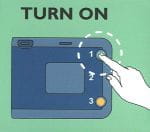The Heartstart FRx Defibrillator, an automated external defibrillator (AED), can save lives. The AEDs are placed in buildings on the Indianapolis campus of IU School of Medicine to treat ventricular fibrillation, the most common cause of sudden cardiac arrest. All students, faculty and staff of IU School of Medicine should know the signs and know where to find an AED in campus buildings.
AED IU Indianapolis campus locations.
AEDs are located in public areas of each IU Indianapolis building in a white metal cabinet with an AED wall sign above the cabinet. When the cabinet is opened, a local alarm sounds and the campus police operator is notified. It is still important to call 9-1-1 to get paramedics and campus police to the location.


